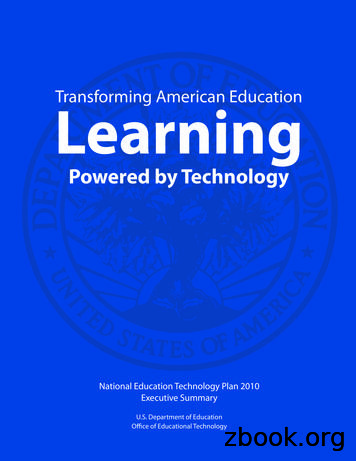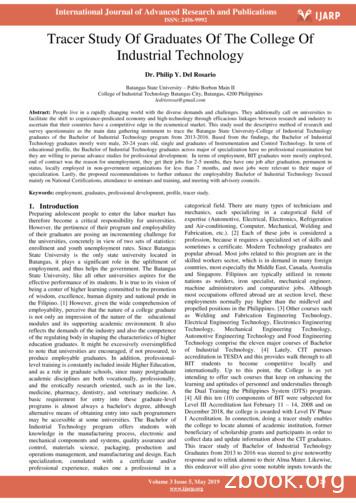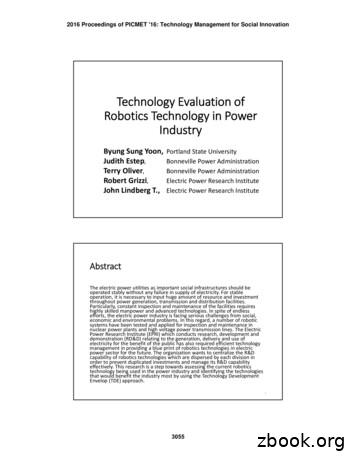SPHEREA Technology
SPHEREA TechnologyPresentation:ATML Tools Overview OSA-RTS ModuleDate: 28 April 2015 2015 SPHEREA Technology Ltd - All rights reserved
ATML Open COTS Solution ArchitectureAn overview of the various tools (including eXpress, newWaveX andTestStand) that support ATML Open COTS Solution Architecture.The presentation will run through the various standards including IEEEATML 1671 and SIMICA 1636 their relationship with other standards e,gS-Series ILS (S5000F) and the COTS components that integratetogether to allow users to build and maintain their own ATML standardscompliant architecturesA insight into the OSA-RTS (Open Source Software) than integrates theATML Test Description with Test Stand (and other tools) to provide aTPS process for creating and running test programs using ATMLstandards and 1641 Signals, on a variety of Hardware Abstraction Layers(HAL) implementations 2015 SPHEREA Technology Ltd - All rights reserved
ATML-Powered, COTS Based ATS Software Solution 2015 SPHEREA Technology Ltd - All rights reserved
ATML-Powered, COTS Based ATS Software Solution 2015 SPHEREA Technology Ltd - All rights reserved
Use and interoperability of Standards 2015 SPHEREA Technology Ltd - All rights reserved
Modern IEEE standards—supporting interoperability & longevity Automatic Test Markup Language (1671) and SIMICA (1636)– ATML suite of XML Schema standards supporting informationinterchange– ATML – IEEE Std. 1671 Standard for exchanging test information required for the diagnosis, test and repair ofequipment.– SIMICA - IEEE Std. 1636 (aka ATML Test Results) Standard(s) for exchanging test results, session information and the outcome ofmaintenance actions associated with the test, diagnosis and repair of equipment. Developed by IEEE Standards Coordinating Committee onTest and Diagnosis for Electronic Systems (SCC20)– Chair Mike Seavey (US) michael.seavey@ngc.com– Vice-chair Chris Gorringe (UK) chris.gorringe@eads-ts.com Associated with IEC TC91 WG 15 Testing of ElectrotechnicalProducts continues to handle SCC20 activities and to maintainthe related International Standards– Publishing SCC20 Standards as IEC dual Logo standards6
SCC20 suite of test information standards Why are these standards needed?– Provides system independent test definitions Portable between compliant systems Simplifies re-host when ATS reaches end-of-life– Facilitates information transfer Common information exchange format using XML Simplifies exchange of test & diagnostic information Results saved in common format but may be printed or displayed in anyrequired style. A standard XML exchange format for sharing information between AutomaticTest System (ATS) components–––––– test dataresults dataresource dataUUT datadiagnostic datahistoric dataSupports test program, test asset and UUT interoperability7
SCC20 suite of test information standards Using a common XML format:– Different tools and systems can exchange information– Heterogeneous systems may co-operate, resulting in: 8Decreased test timesReduced incidents of Can Not Duplicate or No Fault FoundReduced Repair CycleFormalized capture of historic dataImproved closed loop diagnostic systems
MOD Policy – Def Stan 66-31 Part 8 includes Table D.2—Test information interchange standardsReferenceIEEE Std 1636TitleIEEE Standard for Software Interface for Maintenance Information Collection and Analysis (SIMICA)IEEE Std 1636.1 IEEE Standard for (SIMICA): Exchanging Test Results and Session Information via the eXtensible Markup Language (XML)IEEE Std 1636.2 IEEE Standard for (SIMICA): Exchanging Maintenance Action Information via the Extensible Markup Language (XML)IEEE Std 1671IEEE Standard for Automatic Test Markup Language (ATML) for Exchanging Automatic Test Equipment and Test Informationvia XMLIEEE Std 1671.1 IEEE Standard (ATML) for Exchanging ATE and Test Information via XML: Exchanging Test DescriptionsIEEE Std 1671.2 IEEE Standard (ATML) for Exchanging ATE and Test Information via XML: Exchanging Instrument DescriptionsIEEE Std 1671.3 IEEE Standard (ATML) for Exchanging ATE and Test Information via XML: Exchanging UUT (Unit-Under-Test) DescriptionInformationIEEE Std 1671.4 IEEE Standard (ATML) for Exchanging ATE and Test Information via XML: Exchanging Test Configuration InformationIEEE Std 1671.5 IEEE Standard (ATML) for Exchanging ATE and Test Information via XML: Exchanging Test Adapter InformationIEEE Std 1671.6 IEEE Standard (ATML) for Exchanging ATE and Test Information via XML: Exchanging Test Station Information9
SCC20 Test Information suite of standardsATML Overview and Architecture IEEE Std 1671-2010Signal and Test Definition (STD)IEEE P1641 - 2010ATML Instrument DescriptionIEEE Std 1671.2-2012ATML Test Station DescriptionIEEE Std 1671.6-2015ATML Test Adapter DescriptionIEEE Std 1671.5-2015XMLATML Test ConfigurationIEEE Std 1671.4-2014ATML UUT DescriptionIEEE Std 1671.3-2007ATML Test DescriptionIEEE 1671.1-2009SIMICA Test ResultsIEEE Std 1636.1-2013SIMICA Maintenance ActionIEEE Std 1636.2-2010ATML Common, Hardware Common, Test Equipment, Capabilities, Wire Lists; Test Results Collection;IEEE P1671-2010Key:W3C StandardTrial-Use Standard approvedby the IEEE-SACompleted ballot process,ready for approval andpublication by the IEEE-SARevision to Published IEEEFull-Use StandardRevision to IEEE 1641 FullUse StandardIn IEEE ballot process
Comparison of S5000F - ILS Data ModelsS5000F §34TitleOperational and maintenancedata feedback businessprocessFeedback data for the purposeof RAMCTSynergy(see 140602-RPT-SCM002-Task04, Annex A, Table 2 for full details of synergy)Perform Reliability, Availability, Maintainability Analysis, Level of Repair analysis, maintenance task analysis (MTA) and(Re)Analyze support equipment requirements.Helps identify values such as Actual MTBF, Performance of MTBF, Actual-NFF-Rate, Performance of NFF-Rate, Actual-MTTR,Performance of MTTR, Actual-Task Frequency, Performance of maintenance frequencyReliability Data; i.e. Failure rate, MTBF, MDT.Availability Data, i.e. Inherent Availability, MTBF / MTBF MTTR.Maintainability Data, i.e. MMH, MRT or MACMT, time to upload software, MTTR.5Feedback of data formaintenance analysisTestability Data, i.e. Time to undertake test, Ease of access, Ability to locate fault, Ease of understanding test resultsUnscheduled Maintenance Reports, i.e. failure description, date of failure, actual product and/or component usage when failureoccurred, product family and product registration, reference to maintenance manual, component replaced, Man hours, Workingtime.Scheduled Maintenance reports, i.e. Work orders, material consumption.Repair Shop, i.e. Shop reports, Reliability trends for components repaired, Maintenance information of parts used.7Feedback of data to supportLSA data updateField and Depot Repair facilities, i.e. product maintenance performed, component failures with usage and environmentinformation, time taken to perform scheduled maintenance tasks, data on parts replaced and consumables used.FMECA and MTA (S3000L), i.e. Maintenance Level and skills, Actual Maintenance Task man-hours and elapsed time, Failuremode and causes, Failure operational condition and/or mission, Repair actions taken and materials consumed, Failure andDefect rates, Item identifier (P/N, S/N, LCN values).891315Feedback for Life Cycle CostanalysesFeedback of data for warrantyanalysisProvides details of repair and maintenance costs incurredFeedback for ProductConfigurationFeedback of non-predefinedinformationReferences hard descriptions that contain different build standard and configured itemsIdentifies Warranty related maintenance and repairStandard supports several predefined methods for handling ‘extension’ information i.e. where to put new non-predefinedinformation11ColourCode
Test Results Information12
Maintenance Information13
Chapter 3: Operational and maintenance datafeedback business process overlap14
Chapter 4: Feedback data for the purpose ofRAMCT Overlap15
Chapter 5: Feedback of data for maintenance analysisOverlap16
Chapter 7: Feedback of data to support LSAdata update Overlap17
Chapter 8: Feedback for Life Cycle Costanalyses Overlap18
Chapter 9: Feedback of data for warrantyanalyzis Overlap19
Chapter 13: Feedback for Product ConfigurationOverlap20
Chapter 15: Feedback of non-predefinedinformation Overview21
S5000F & IEEE Std 1636.x Overlap22
Open System Architecture Runtime System 2015 SPHEREA Technology Ltd - All rights reserved
Runtime System(s) 2015 SPHEREA Technology Ltd - All rights reserved
Runtime System(s) 2015 SPHEREA Technology Ltd - All rights reserved
Open System Architecture Runtime System (OSA–RTS)Overview GoalsSolutions supporting the Open SystemArchitecture - particularly ATML (IEEE Std1671) and 1641 (IEEE Std 1641) - offersignificant through-life cost savings.Implementations that utilise 1641 andATML are varied in software architecturefor both TPS & ATS; several differentvendors’ products are included in the OSARTS.A number of ATML and 1641 COTS toolsare now available which has led to theconclusion that a system could be builtfrom these COTS tools that would bringATML with 1641 compliance to existingATS Architectures, while capitalising theinvestment made in these existing run-timetools, configuration data and training. 2015 SPHEREA Technology Ltd - All rights reserved
Overview - IntroductionThe Open System Architecture Runtime System (OSA-RTS) provides acommon framework of shared ATS components that implement ATMLsolutions for translating ATML’s Test Descriptions and Test EquipmentDescriptions into run able test programs.The current OSA-RTS framework has been designed for the C, C andC# textual programming languages, but specifically for LabWindows /CVI.27 2015 SPHEREA Technology Ltd - All rights reserved
OSA–RTS OverviewIntroduction Requirement: Test System softwareframework. Open Systems Architecture IEEE 1641 IEEE ATML. Open Source Software– Available to contractorsemployed in the provisionof test system software tothe MoD & coalitionpartners. 2015 SPHEREA Technology Ltd - All rights reserved
OSA–RTS OverviewOSA ArchitectureTest Executive (TestStand / C# TPS)1641 Runtime1641TestTestStandnewWaveX1641 IDLCVISignal RouteingIVISwitchIVI SwitchIEEE 1641TSF LibrariesXMLTSFATMLToolkitSequence1641 SignalTranslator1641TPL1641 SignalInterfaceATMLPadSignalSignalSignalATML ImporterATML TestDescription st DecriptionXpress ServicesTSFBSCBSCBSCCapability DriverDescriptionIEEE 1641TSF LibrariesIDLIEEE ATMLTest Station /Instrument Desc.BSCResourceTSFTSFTSFBSCIEEE 1641TSF LibrariesXMLTSFBSCBSCBSCBSC1641 TSF IDLGeneratornewWaveXKey:Open Source SoftwareCOTS ToolIEEE 1641 Signal 2015 SPHEREA Technology Ltd - All rights reserved
MOD OSA-RTS Asset RepositoryThe diagram shows the OSA-RTS architecture used for migrating ATML test descriptions (IEEE Std1671.1), (utilizing IEEE Std 1641 signals), into run-able code using TestStand sequences, CVI CodeModules and a 1641 Run-time interface which makes calls to underlying test resources. ATML Pre-processor (New OSA Component)ATML Test Description Importer:– Converts ATML test requirements into a test program implementation carrying 1641 TestProcedure Language.1641 Signal Translator– Maps test signal requirements onto test resource capabilities (making use of ATML TestStation Description).Signal Routing– Connects test resources to UUT pins.1641 Test Signal Framework IDL Generator– Generates a run-time interface from 1641 signal libraries.1641 Run-time– Implements a 1641 runtime interface with calls to underlying test resources.15 Oct 201330
OSA–RTS OverviewATML Pad Pre-processor Visual editor for ATMLComprehensive ATML data validationIntegrated with TestStand ATML TranslatorPlug-in importer architecture– Conversion to standard ATML st DecriptionATMLPadSignalSignalSignalIEEE 1641TSF LibrariesXMLTSFBSCBSCBSC
OSA–RTS OverviewATML ImporterCOTSIEEE 1641TSF LibrariesXMLTest StandSequenceContaining 1641TPLSignalSignalSignalATMLToolkitTest (CVI)1641 TPLTest StandCVIIEEE 1641TSF LibrariesXMLTSFBSCATML ImporterATMLTest DecriptionATML TestDescription ImportSignalSignalSignalATML ImporterATML TestDescription ImportATMLTest DecriptionTSFBSCBSCBSCBSCBSCOverview 2015 SPHEREA Technology Ltd - All rights reservedArchitectureATML Toolkit creates: Test Stand sequence and CVI test actions. Test Stand sequence and LabVIew VI actions1641 Signal statements create call-backs into Open SourceSoftwareOSA translates 1641 Signal statements in test actions into TPL.
OSA–RTS Overview1641 Signal Translator-11641 SignalTranslator1641 TPLTest1641 IDLIEEE 1641TSF LibrariesXMLTSFBSCBSCBSCCapability DriverDescriptionIEEE ATMLTest Station /Instrument Desc.BSCResourceBSCBSC 2015 SPHEREA Technology Ltd - All rights reserved1641 SignalInterfaceCOTS
OSA–RTS Overview1641 TSF IDL Generator-1IEEE 1641TSF LibrariesXMLTSFBSCIEEE 1641TSF LibrariesIDLBSCIEEE ATMLTest Station /Instrument Desc.BSCTSFTSFTSF 2015 SPHEREA Technology Ltd - All rights reservedResource1641 TSF IDL GeneratorBSCBSCBSCCOTS
Final Overlay of OSA RTS Components on Requirement Diagram1641 TSF IDLGeneratorCassidiannewWaveXTest Executive(TestStand / C# TPS)Test1641 IDLATML Importer1641 RuntimeNI ATMLToolkit1641IVI SwitchCassidiannewWaveXTSF1641 SignalTranslatorSignal RouteingTeradyneXpress ServicesCapability DriverDescriptionInstrumentKey:Open Source SoftwareCOTS ToolIEEE 1641 Signal 2015 SPHEREA Technology Ltd - All rights reserved
OSA–RTS OverviewOSA COTS – Full ArchitectureSignalSignalSignal1641 SignalTranslatorSignal LifetimesATML ImporterATMLToolkitNI Test StandSequenceTestInstrumentCodeSwitch Services1641 ntNI Test StandSequenceTestIEEE 1641TSF LibrariesXML & IDL1641 IDLATMLTest anagerBSCBSC1641 IDLIEEE ATMLTest Station /Instrument ility DriverDescriptionBSCBSCIEEE Std. 1641 Compliant SystemKey: 2015 SPHEREA Technology Ltd - All rights reservedCOTSFuture TPS Language CompliantSystemIEEE 16411641 SignalInterfaceOpen System Architecture Compliant SystemATML TestDescription ImportInstrument1641 IDLInterfaceOpen SourceATE SystemOther Standard
OSA–RTS OverviewOpen Source AssetsTest Executive (TestStand / C# TPS)16411641 RuntimenewWaveX1641 IDLCVIIVI SwitchIEEE 1641TSF LibrariesXMLTSFTestTestStand1641 SignalInterfaceATMLToolkitSequence1641 ATML ImporterATML TestDescription st DecriptionSignal RouteingXpress ServicesTSFBSCBSCBSCCapability DriverDescriptionIEEE 1641TSF LibrariesIDLIEEE ATMLTest Station /Instrument Desc.Key:Open Source SoftwareCOTS ToolBSCResourceBSCIEEE 1641TSF LibrariesXMLTSFBSCIEEE 1641 SignalBSCBSC 2015 SPHEREA Technology Ltd - All rights reservedBSC1641 TSF IDLGeneratornewWaveXTSFTSFTSF
OSA–RTS OverviewCOTS Components National Instruments ATML 2013– NI provides an ATML Toolkit that supplements NI TestStand to import ATML Test Description and testsequences & actions and, also, export ATML Test Results. The Toolkit is not intended to handle IEEE 1641Signals; it provides an API (Application Programmer Interface) to supplement its capability, using such toolsas Cassidian newWaveX. National Instruments Test Stand 2013– NI TestStand comprises the test sequencer and test executive and is used to assist in the development ofautomated test sequences, a key component of a TPS. TestStand is both a development and executionenvironment in this respect.– In terms of an ability to exchange test definitions to support portability of tests, TestStand is generallyconsidered to be a closed and proprietary test environment, though it has significant universal acceptanceand ongoing support. Despite this, signal and sequence test code contained within the tool is accessible tothe user and hence the inclusion of this tool in open systems architectures has been recommended. National Instruments LabWindows /CVI 2013 SP1– LabWindows/CVI is a proven ANSI C development environment for test and measurement that greatlyincreases the productivity of engineers and scientists. For more than 20 years, C developers have usedLabWindows/CVI to develop high-performance, stable applications in the manufacturing test, military andaerospace, telecommunications, design validation, and automotive industries. LabWindows/CVI streamlinesdevelopment with hardware configuration assistants, built-in measurement libraries, comprehensivedebugging tools, interactive execution capabilities that developers can use to run functions at design time,and advanced analysis and scientific user interface tools.January 201438
OSA–RTS OverviewOSA RTS Ready - COTS ComponentsnewWaveX IEEE 1641 Signal-based test and measurement software fulfils twospecific functions: newWaveX SD (Signal Development)–A complete graphical signal modelling & simulation environment forautomatic test, compliant with the following standards’ signal requirements: IEEE 1641 Signal & Test Definition. IEEE 1671.1 ATML Test Description. IEEE 1671.2 ATML Instrument Description. IEEE 1671.6 ATML Test Station.–newWaveX SD supports the creation and editing of IEEE 1641 Signals &TSF libraries; XML, XSD, IDL and HTML file formats for storage, interfacespecification and documentation. Additionally, newWaveX SD providesActiveX controls, enabling easy embedding in third-party applications. newWaveX PD (Platform Development)–A test platform integration toolset, targeted at getting test signals to testpins, newWaveX PD fulfils two primary functions: A resource (instrument) description and validation environment for:– IEEE Std.1671 ATML Instrument and Test StationDescription. A compile-time resource manager/translator, reading signalorientated test program descriptions and outputting driver orientatedtest code, applicable to:– IEEE Std. 1641 IDL and TPL– IEEE Std. 1671 ATML Test Description.January 201439
ATML Pad Pre-processorCOTS Components ATML Pad– Visual editor for ATML– Comprehensive data validation– Integrated with TestStand ATMLTranslator– Plug-in importer architecture Conversion to standard ATMLformat
OSA–RTS OverviewCOTS Components NI Switch Executive 3.6 IVI Instrument Programming Specifications– E.g. NI IVI Compliance Package 4.4 Microsoft Visual Studio .NET C# 2010 (eXpress versions)– MS Visual Studio is an IDE and command line toolset for software development.Pertaining to the RTS, it provides C# coding, interface stub generation,compilation and IDL compilation to type library.January 201441
ATML-Powered, COTS Based ATS Software Solution 2015 SPHEREA Technology Ltd - All rights reserved
Thank you for your detention!The reproduction, distribution and utilization of this document as well asthe communication of its contents to others without express authorizationis prohibited. Offenders will be held liable for the payment of damages.All rights reserved in the event of the grant of a patent, utility model or design.January 201443
OSA-RTS (LabView Version) 2015 SPHEREA Technology Ltd - All rights reserved
Overview and BackgroundThe Use of LabVIEW with the OSA-RTSMarch 2015
Overview - IntroductionThe Open System Architecture Runtime System (OSA-RTS) provides a commonframework of shared ATS components that implement ATML solutions for translatingATML’s Test Descriptions and Test Equipment Descriptions into run able test programs.The current OSA-RTS framework has been designed for the C, C and C# textualprogramming languages, but specifically for LabWindows / CVI.The popularity of LabVIEW in the test and data acquisition industry highlights the nee
IEEE Std 1636.1 IEEE Standard for (SIMICA): Exchanging Test Results and Session Information via the eXtensible Markup Language (XML) IEEE Std 1636.2 IEEE Standard for (SIMICA): Exchanging Maintenance Action Information via the Extensible Markup Language (XML) IEEE Std 1671 IEEE Standard for Automatic Test Markup Language (ATML) for Exchanging Automatic Test Equipment and Test Information via .
Transforming American Education National Education Technology Plan 2010 Executive Summary U.S. Department of Education O!ce of Educational Technology Learning Powered by Technology. Transforming American Education National Education Technology Plan 2010 Executive Summary U.S. Department of Education O!ce of Educational Technology Learning Powered by Technology. 6HFWLRQ RI WKH (OHPHQWDU\ DQG .
Using Technology to Advance Your Mission Not-for-Profit Leadership Summit VI May 12, 2008. Rye Town Hilton. Presenters: Ken Belfer and Dale Mottola. Workshop Outline 1. Technology Planning. 2. Technology on a Not-for-Profit Budget. 3. How Technology Can Help Achieve Your Mission. 4. Q & A with Panel. Technology in Your Organization
Teaching and Technology: The Potential 8 Teachers and Technology: The Barriers 18 Promising Approaches to Technology Implementation 28 Current Federal Support for Teacher Training and Technology 29 Federal Policy Issues and Options 29 Conclusion 46 2 The Promise of Technology for Teachers 49
Electronic Engineering Technology (AAS) program, contact Alán Fuentes at alan.fuentes@bcc.cuny.edu or (718) 933-1604. Continuing your education: The Electronic Engineering Technology (AAS) articulates with Electrical Technology at New York City College of Technology and with Science, Mathematics & Technology at SUNY Empire State.
as Welding and Fabrication Engineering Technology, Electrical Engineering Technology, Electronics Engineering Technology, Mechanical Engineering Technology, Automotive Engineering Technology and Food Engineering Technology comprise the eleven major courses of Bachelor of
1.2 Importance of Spending Time on Design 9 Chapter 2 Technology Assessment Scope and Design 11 2.1 Sound Technology Assessment Design 11 2.2 Stages and Considerations for Technology Assessment Design 12 2.2.1 GAO Technology Assessment Design Examples 18 Chapter 3 Approaches to Select Technology Assessment Design and Implementation Challenges .
This research is a step towards assessing the current robotics technology being used in the power industry and identifying the technologies that would benefit the industry most by using the Technology Development . Design Criteria 3065 2016 Proceedings of PICMET '16: Technology Management for Social Innovation. 23 Calculation of Technology .
Agile Software Development is not new, in fact it was introduced in the 1990s as a way to reduce costs, minimize risks and ensure that the final product is truly what customers requested. The idea behind the Agile approach is that instead of building a release that is huge in functionality (and often late to market), an organization would adapt to dynamic changing conditions by breaking a .























